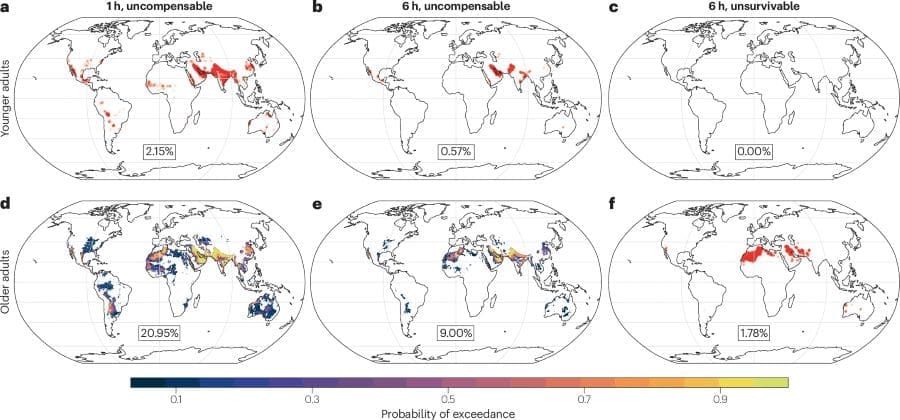In brief:
Summary:
Large portions of the planet could become too hot for humans if global warming reaches 2°C above pre-industrial levels, according to a study published in Nature Reviews Earth and Environment.
The research, led by King’s College London, finds that land areas exceeding critical heat thresholds — where even healthy young adults cannot maintain a safe body temperature — will triple in size, covering about 6% of the Earth’s surface, an area nearly as large as the United States. For those over 60, the risk is even greater, with extreme heat potentially affecting more than a third of global landmass.
The study warns that prolonged exposure to such conditions, even in the shade with hydration, could lead to lethal heatstroke. With the world already surpassing 1.5°C of warming in 2023, and 2°C projected to be reached by mid-to-late century, scientists stress the need for urgent mitigation and adaptation efforts to prevent catastrophic heat-related mortality.

Half a degree rise in global warming will triple area of Earth too hot for humans
An international group of scientists, led by King’s College London, has revealed how continued global warming will lead to more parts of the planet becoming too hot for the human body over the coming decades.
The paper, published in Nature Reviews Earth and Environment, finds that the amount of landmass on our planet that would be too hot for even healthy young humans (18-60-year-olds) to keep a safe core body temperature will approximately triple (to six percent) – an area almost the size of the US – if global warming reaches 2°C above the preindustrial average.
Under these conditions, they also warn that the area of land where the over 60s will be at risk will increase to about 35%.
Last year was the first calendar year with a global mean temperature of more than 1.5°C above the pre-industrial average, and at current rates of warming, 2°C could be reached by mid to late century.
Dr Tom Matthews, lead author and Senior Lecturer in Environmental Geography at King’s College London said: “Our findings show the potentially deadly consequences if global warming reaches 2°C. Unsurvivable heat thresholds, which so far have only been exceeded briefly for older adults in the hottest regions on Earth, are likely to emerge even for younger adults.
“In such conditions, prolonged outdoor exposure – even for those if in the shade, subject to a strong breeze, and well hydrated – would be expected to cause lethal heatstroke. It represents a step-change in heat-mortality risk.”
For their assessment, the team drew together scientific findings to link physical climate science with heat mortality risk, including crossing ‘uncompensable’ and ‘unsurvivable’ thresholds. Scientists distinguish between uncompensable thresholds, beyond which human core body temperature rises uncontrollably, and unsurvivable thresholds, where the body’s core temperature increases to 42°C within six hours.
Between 1994-2023, human thermal tolerances, the combination of temperature and humidity, above which the human body can’t cope – were breached for about 2% of the global land area for adults under 60. More than 20% of the Earth’s land surface crossed this threshold for older adults, who are more vulnerable to heat stress.
Whilst uncompensable thresholds have been passed for all ages, unsurvivable thresholds have so far only been passed briefly for older adults.
For higher warming levels of 4-5°C above preindustrial, older adults could experience uncompensable heat across around 60% of the Earth’s surface during extreme events. At this level of warming, unsurvivable heat would also begin to emerge as a threat to younger adults in the hottest subtropical regions.
Certain regions are more at risk of crossing the critical uncompensable and unsurvivable thresholds, with people in Saharan Africa and South Asia most in the firing line.
Dr Matthews said anticipating the magnitude of future heat extremes and their worst-case impacts is critical to understanding the costs of failing to mitigate climate change. It is also crucial for targeting adaptation efforts at those communities most in need.
“What our review really shows very clearly is that, particularly for higher levels of warming such as 4°C above the pre-industrial average, the health impacts of extreme heat could be extremely bad,” he said.
“At around 4°C of warming above preindustrial levels, uncompensable heat for adults would affect about 40% of the global land area, with only the high latitudes, and the cooler regions of the mid-latitudes, remaining unaffected.
“Interdisciplinary work is vital to improving our understanding of unprecedented heat’s deadly potential and how it can be reduced. As more of the planet experiences outdoor conditions too hot for our physiology, it will be essential that people have reliable access to cooler environments to shelter from the heat.”
Since 2000 there have been more than 260,000 heat related fatalities in the deadliest heat events, showing how extreme heat is already a huge threat to human life.
The three deadliest heat events of the 21st Century collectively caused nearly 200,000 deaths, including about 72,000 across Europe during 2003, another 62,000 across Europe in 2022, and the Russian heatwave of 2010, which killed around 56,000.
***
The study also involved Dr Josh Foster from King’s College London, and researchers from the University of California, Stanford University, the NASA Goddard Institute for Space Studies, Columbia University and Boston University.
Journal Reference:
Matthews, T., Raymond, C., Foster, J. et al. ‘Mortality impacts of the most extreme heat events’, Nature Reviews Earth & Environment (2025). DOI: 10.1038/s43017-024-00635-w
Article Source:
Press Release/Material by King’s College London
Featured image credit: Freepik




